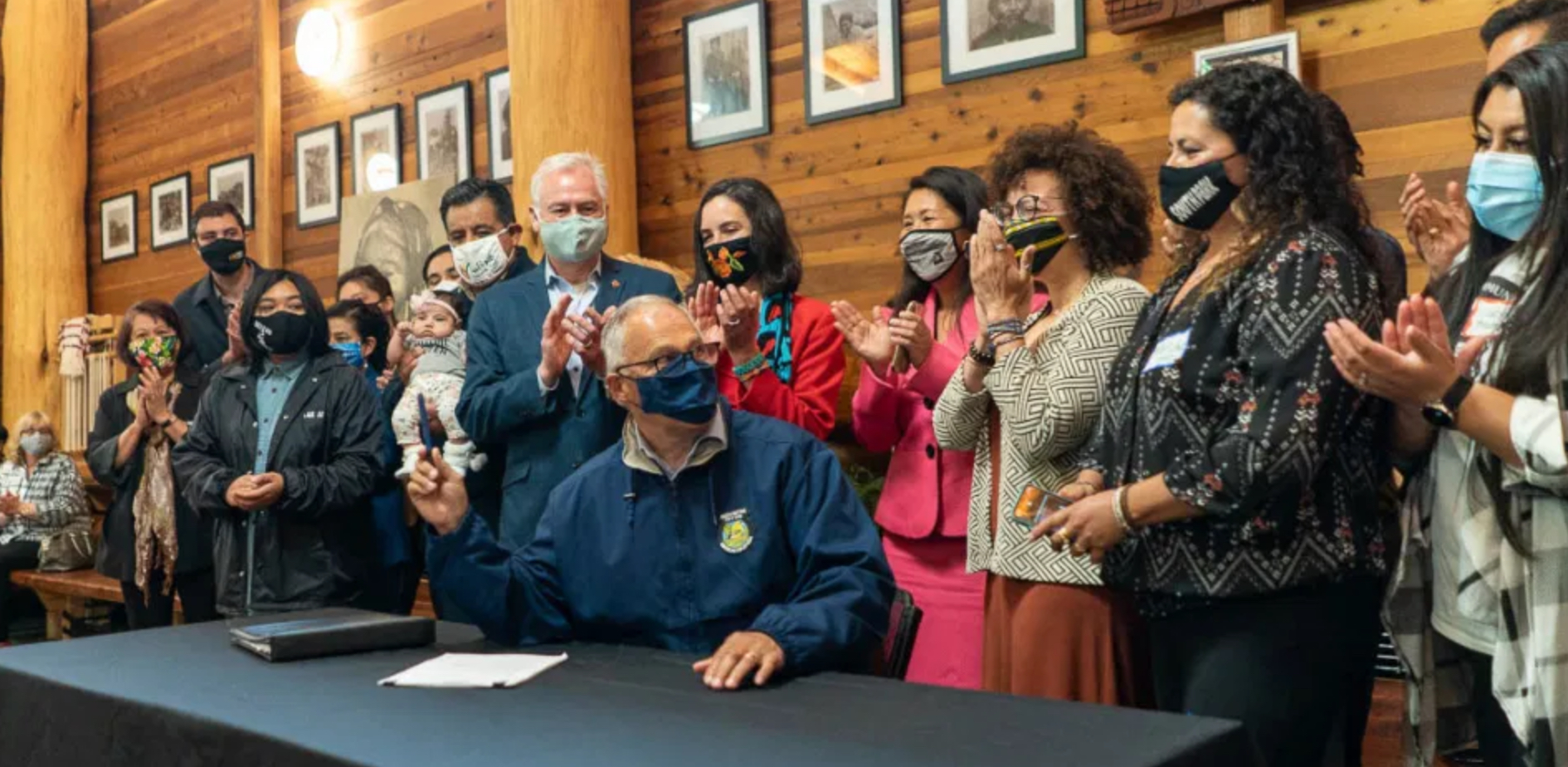By Jack Russillo/South Seattle Emerald
This story is contributed by The South Seattle Emerald, a partner in InvestigateWest’s yearlong climate reporting initiative.
 When the time arrived for Gov. Jay Inslee to sign a far-reaching piece of environmental justice into law, the ceremony took place by the mouth of Seattle’s only river, the Duwamish, at the cultural center of the people who have called themselves by the same name for generations.
When the time arrived for Gov. Jay Inslee to sign a far-reaching piece of environmental justice into law, the ceremony took place by the mouth of Seattle’s only river, the Duwamish, at the cultural center of the people who have called themselves by the same name for generations.
“The HEAL Act is a major piece of legislation with the ambitious charge of making it so that everyone, especially the most overburdened communities and people of color, have a healthy environment, clean air and water, and can lead healthy lives,” said Cecile Hansen, chairwoman of the Duwamish Tribal Council.
The Healthy Environment for All Act was created to “reduce environmental and health disparities in Washington State and improve the health of all Washington State residents,” according to the 2021 WFFA Legislative Report. It mandates that state agencies follow environmental justice principles and practices when making decisions with the potential to create environmental harm. The bill also creates a framework for the state to distribute funding and incorporate community feedback to assist historically overburdened communities in recovering from past harm and to prevent future disparities.
To safeguard against environmentally harmful actions, the law establishes state government processes, such as tracking each agency’s goals and its performance in adopting community engagement plans.
The HEAL Act does not, however, require all agencies to act on all recommendations from the Environmental Justice Task Force. Instead, legislators added language like “consider,” “seek,” and “where practical” when specifying when agencies need to follow the task force’s guidelines. Washington’s departments of Agriculture, Commerce, Ecology, Health, Natural Resources, and Transportation are required to implement these environmental justice frameworks, but other agencies only “should strive to apply the laws” and the equity principles.
“With this bill in effect, we now are starting to make environmental justice a component of everything that we do in state government,” Inslee said at the signing. “This is a far-reaching bill because it’s going to require state agencies to think about this issue in their budgeting and their legislative priorities. This is an order to bring environmental justice to the forefront of everything we do. It’s about time that we do this. We have too many areas in the state of Washington where overburdened communities are breathing diesel smoke from freeways and breathing toxic fumes from industrial centers. It’s time to do something about that.”
The HEAL Act defines environmental justice based on the finding of the environmental task force, which was formed in 2019 to develop recommendations for embedding environmental justice and improving the health of populations disproportionately impacted into each public agency’s responsibilities.
The state’s new, legal definition of environmental justice is: “the fair treatment and meaningful involvement of all people, regardless of race, color, national origin, or income, with respect to the development, implementation, and enforcement of environmental laws, regulations, and policies.” This includes addressing disproportionate health and environmental health impacts, prioritize highly impacted populations, equitably distribute resources and benefits, and eliminate harm.”
“Today is a day of celebration and it is a day to heal,” said state Rep. Debra Lekanoff, who represents the 40th district and was a sponsor of the bill. “Today we are bringing environmental health to all. The HEAL Act is a celebration for all Washingtonians.”
According to a report from the Environmental Justice Task Force in 2020, “People of color and low-income people continue to be disproportionately exposed to environmental harms in their communities.” These frontline communities are often Indigenous and other people of color, with lower incomes and are linguistically isolated. They are often hit first by the effects of pollution and extractive practices and policies, making their existing health and economic disparities worse, and yet these frontline communities are often not prioritized in corrective policy that can lead to healthier and more sustainable futures.
“Today is a monumental day for our movement, for climate and environmental justice,” said state Sen. Rebecca Saldaña, who represents the 37th district and was a primary sponsor of the bill. “It is about how we approach all the work that we do and … those practices that resulted in systems and institutions that led to those disparities that we now see on the map and shows that, by design, certain communities pay a much higher price in health and in opportunity than others based on where they live. And so, it’s these policies that have brought us here today to undo those harms and, as the governor said, to ensure that environmental justice drives all that we do as we move forward together for a Washington that is worthy of our children and our grandchildren.”
The act also aims to address environmental health disparities that occur on tribal lands, particularly ones “due to off-reservation activities within the state,” and “on small reservations where it is impossible to move away from a hazard.” The law will also help to “improve state practices to reduce contamination of traditional foods wherever they occur.”
Additionally, the HEAL Act says that by July 2022, state agencies “must create and adopt a community engagement plan that describes how it will engage with overburdened communities and vulnerable populations,” and that their plan “must describe how the agency plans to facilitate equitable participation and support meaningful and direct involvement of vulnerable populations and overburdened communities.”
“You saw a coalescence of justice from all these communities and, obviously, having this event at a tribal location is very important,” said Inslee. “We have representatives of the Latinx community who were speaking about agricultural justice in the field. We have community members who care about bringing about police accountability. So, it’s all about a coalescence of justice messages in multiple platforms: agriculture, police accountability, environmental, and clean air laws. It’s so wonderful to see that we’re advancing justice, not just in one stream, but in multiple streams. Today was a big day.”
On the same day, however, Inslee issued a line-item-veto of the Climate Commitment Act that could have given tribes the opportunity to stop carbon tax revenues from funding state projects that they say would harm their cultural resources and sacred sites. In response to Inslee’s veto, the Washington BLM Alliance released a statement that said “vetoing the entire Tribal consultation section of this bill is a direct and imminent threat to Tribal civil rights and protections” and that “the state must honor those rights by requiring consultation with Tribes when their cultural resources are under threat.




I believe the issue is tribal consent not consultation
The Yakama Tribe does not consent to a pumped energy storage project on a former village site near The John Day Dam.
They also want 8 dams removed.